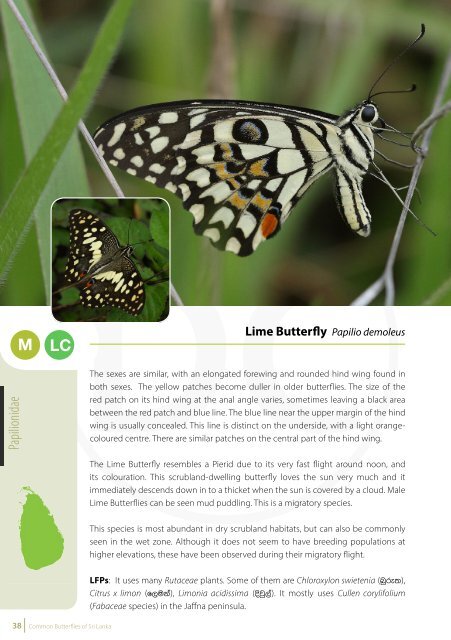Common Butterflies of Sri Lanka
Common Butterflies of Sri Lanka
Common Butterflies of Sri Lanka
You also want an ePaper? Increase the reach of your titles
YUMPU automatically turns print PDFs into web optimized ePapers that Google loves.
Lime Butterfly Papilio demoleus<br />
Red Helen Papilio helenus<br />
M LC L VU<br />
Papilionidae<br />
The sexes are similar, with an elongated forewing and rounded hind wing found in<br />
both sexes. The yellow patches become duller in older butterflies. The size <strong>of</strong> the<br />
red patch on its hind wing at the anal angle varies, sometimes leaving a black area<br />
between the red patch and blue line. The blue line near the upper margin <strong>of</strong> the hind<br />
wing is usually concealed. This line is distinct on the underside, with a light orangecoloured<br />
centre. There are similar patches on the central part <strong>of</strong> the hind wing.<br />
The Lime Butterfly resembles a Pierid due to its very fast flight around noon, and<br />
its colouration. This scrubland-dwelling butterfly loves the sun very much and it<br />
immediately descends down in to a thicket when the sun is covered by a cloud. Male<br />
Lime <strong>Butterflies</strong> can be seen mud puddling. This is a migratory species.<br />
The sexes are almost similar but a variation <strong>of</strong> the pattern on its underside is prevalent<br />
in females. Occasionally there is a small white patch on the upper side towards the<br />
apex on its forewing. The cilia <strong>of</strong> its hind wing are marked in white, with a red mark at<br />
the anal angle. The large white patch on its hind wing is concealed on the upper side,<br />
when the butterfly is resting, but is prominent when it is in flight. Additional white<br />
dustings on its forewing and a sub-marginal row <strong>of</strong> crescent-shaped red patches on<br />
its hind wing can be seen on its underside.<br />
The Red Helen flies along forest paths in a deep, irregular wing beat. It goes much<br />
higher for nectar. It is common to see these butterflies puddling in numbers on wet<br />
patches consisting <strong>of</strong> leaf litter adjacent to streams at mid elevations.<br />
Papilionidae<br />
This species is most abundant in dry scrubland habitats, but can also be commonly<br />
seen in the wet zone. Although it does not seem to have breeding populations at<br />
higher elevations, these have been observed during their migratory flight.<br />
LFPs: It uses many Rutaceae plants. Some <strong>of</strong> them are Chloroxylon swietenia (nqre;),<br />
Citrus x limon (f,uka), Limonia acidissima (Èjq,a). It mostly uses Cullen corylifolium<br />
(Fabaceae species) in the Jaffna peninsula.<br />
This is a damp forested species commonly found in the wet zone, especially at mid<br />
elevations, becoming scarcer towards lower elevations. It is found in considerable<br />
numbers in their natural habitats, but there are only few such pristine habitats<br />
remaining in the country.<br />
LFPs: Zanthoxylum tetraspermum, Toddalia asiatica (l=vqñßiai), Citrus madurensis (kia<br />
kdrx)<br />
38 <strong>Common</strong> <strong>Butterflies</strong> <strong>of</strong> <strong>Sri</strong> <strong>Lanka</strong><br />
<strong>Common</strong> <strong>Butterflies</strong> <strong>of</strong> <strong>Sri</strong> <strong>Lanka</strong> 39















